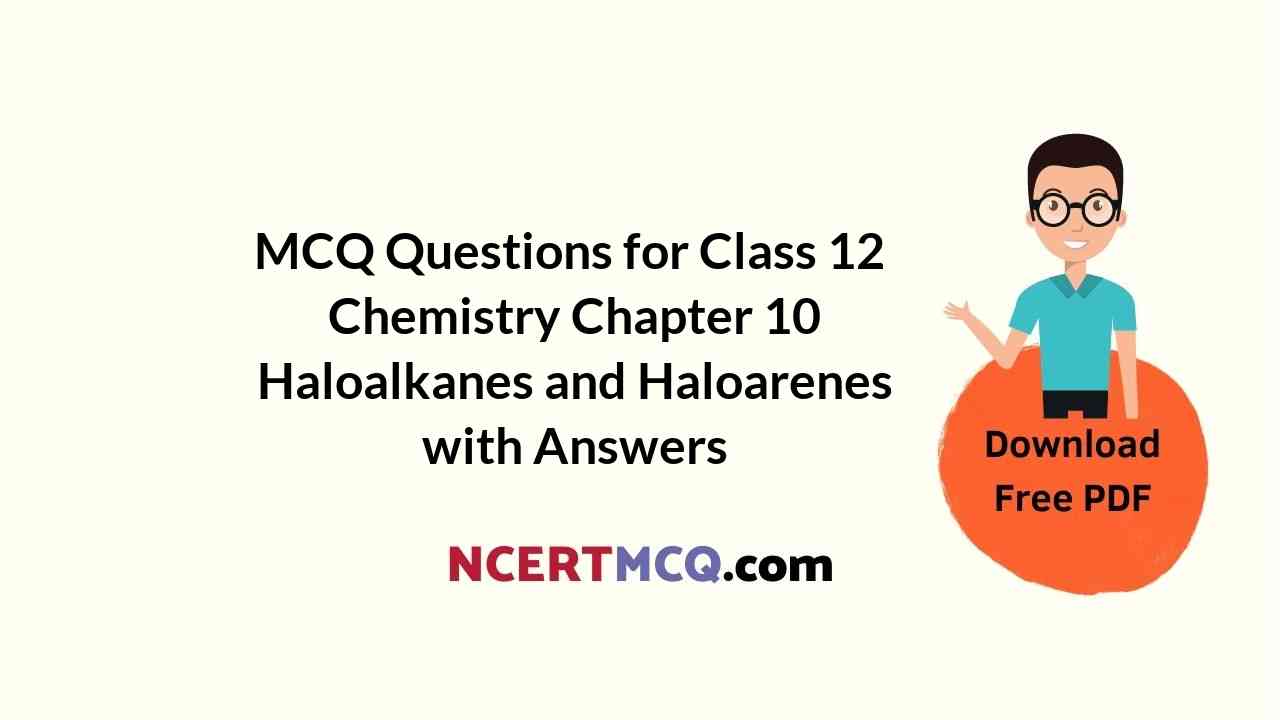Check the below NCERT MCQ Questions for Class 12 Chemistry Chapter 10 Haloalkanes and Haloarenes with Answers Pdf free download. MCQ Questions for Class 12 Chemistry with Answers were prepared based on the latest exam pattern. We have provided Haloalkanes and Haloarenes Class 12 Chemistry MCQs Questions with Answers to help students understand the concept very well.
Class 12 Chemistry Chapter 10 MCQ With Answers
Chemistry Class 12 Chapter 10 MCQs On Haloalkanes and Haloarenes
Haloalkanes And Haloarenes Class 12 MCQ Question 1.
Good conductor of electricity and heat is
(a) Anthracite coke
(b) Diamond
(c) Graphite
(d) Charcoal
Answer
Answer: (c) Graphite
Haloalkanes And Haloarenes MCQ Question 2.
In which of the following allotropes of carbon, percentage of carbon is maximum?
(a) Wood charcoal
(b) Coconut charcoal
(c) Graphite
(d) None of these
Answer
Answer: (c) Graphite
MCQ Of Haloalkanes And Haloarenes Class 12 Question 3.
The hybridisation of carbon in diamond is
(a) sp3
(b) sp2
(c) sp
(d) dsp2
Answer
Answer: (a) sp3
MCQ On Haloalkanes And Haloarenes Class 12 Question 4.
Organic compound must contain an element
(a) oxygen
(b) carbon
(c) hydrogen
(d) nitrogen
Answer
Answer: (b) carbon
Solve using Substitution Calculator solves the linear equations having unknown variables in a fraction of seconds.
Haloalkanes And Haloarenes MCQ Questions With Answers Pdf Question 5.
Alkene gives which of the following reactions?
(a) Addition reaction
(b) Substitution reaction
(c) Both (a) and (b)
(d) None of these
Answer
Answer: (c) Both (a) and (b)
Class 12 Chemistry Haloalkanes And Haloarenes MCQ Question 6.
Single bond length between carbon-carbon is
(a) 1.34 Å
(b) 1.20 Å
(c) 1.54 Å
(d) none of these
Answer
Answer: (c) 1.54 Å
Haloalkane And Haloarene MCQ Question 7.
Valency of carbon is
(a) 1
(b) 2
(c) 3
(d) 4
Answer
Answer: (d) 4
Class 12 Haloalkanes And Haloarenes MCQ Question 8.
Criteria for purity of organic solid is
(a) boiling point
(b) melting point
(c) specific gravity
(d) none of these
Answer
Answer: (b) melting point
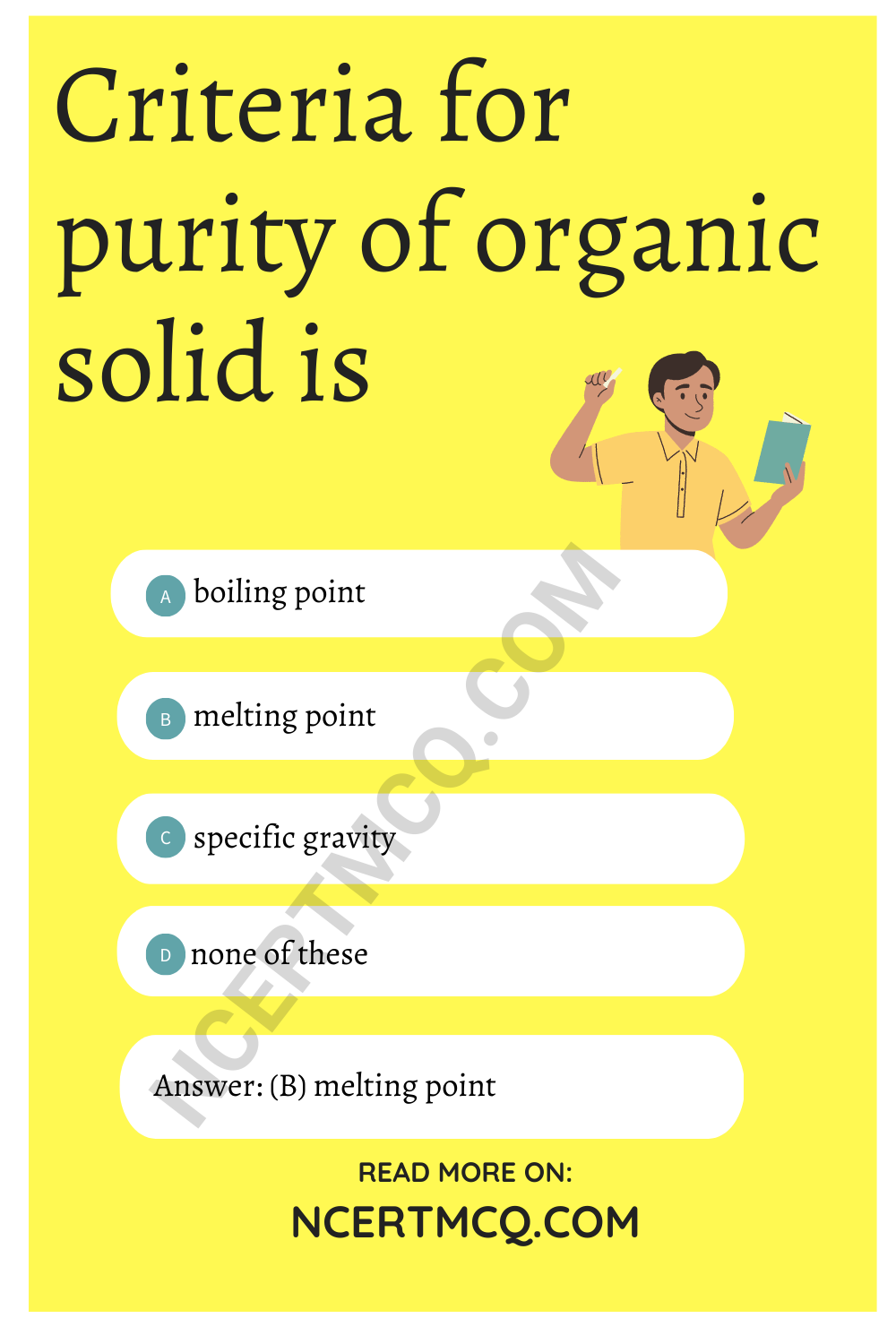
Haloalkanes And Haloarenes Class 12 MCQ With Answers Question 9.
General formula of Alkene is
(a) CnH2n
(b) CnH2n+2
(c) CnH2n-2
(d) none of these
Answer
Answer: (a) CnH2n
MCQ Questions On Haloalkanes And Haloarenes Question 10.
Hybridisation of carbon in ethane is
(a) sp3
(b) sp2
(c) sp
(d) sp3d2
Answer
Answer: (a) sp3
Class 12 Chemistry Chapter 10 MCQ Question 11.
Number of π bonds in ethyne is
(a) 1
(b) 2
(c) 3
(d) 4
Answer
Answer: (b) 2
Haloalkanes And Haloarenes MCQ Class 12 Question 12.
The compound having general formula CnH2n+2 is
(a) Alkene
(b) Alkyne
(c) Alkane
(d) none of these
Answer
Answer: (c) Alkane
MCQ Haloalkanes And Haloarenes Question 13.
Which of the following is not correctly matched with its IUPAC name?
(a) CHF2CBrClF : 1-Bromo-1-chIoro-1, 2, 2-trifluoroethane
(b) (CCl3)3CCl : 2-(Trichloromethyl)-1, 1, 2, 3, 3-heptachloropropane
(c) CH3C (p-ClC6H4)2CH(Br)CH3 : 2-Bromo-3, 3-bis (4- chlorophenyl) butane
(d) o-BrC6H4CH (CH3) CH2CH3 : 2-Bromo-l- methylpropylbenzene
Answer
Answer: (b) (CCl3)3CCl : 2-(Trichloromethyl)-1, 1, 2, 3, 3-heptachloropropane
Haloalkanes And Haloarenes Class 12 MCQs Question 14.
The negative part of the addendum (the molecule to be added) adds on the carbon atom of the double bond containing the least number of hydrogen atoms. This rule is known as
(a) Saytzeffs rule
(b) Peroxide rule
(c) Markovnikov’s rule
(d) van’t hoff rule
Answer
Answer: (c) Markovnikov’s rule
MCQ Questions On Haloalkanes And Haloarenes Class 12 Question 15.
Which of the following compounds can yield only one monochlorinafed product upon free radical chlorination?
(a) 2, 2-Dimethylpropane
(b) 2-Methylpropane
(c) 2-Methylbutane
(d) n-Butane
Answer
Answer: (a) 2, 2-Dimethylpropane
Question 16.
The reaction

is an example of
(a) nucleophilic addition
(b) free radical addition
(c) electrophilic addition
(d) electrophilic substitution
Answer
Answer: (c) electrophilic addition
Integration by Substitution Calculator online with solution and steps.
Question 17.
Halogen acids react with alcohols to form alkyl halides. The reaction follows a nucleophilic substitution mechanism. What will be the product of the following reaction?
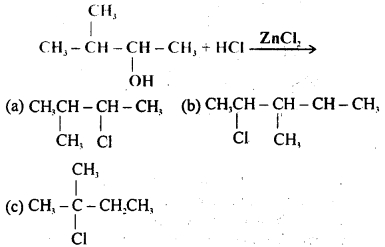
(d) CH3CH2CH2CH2CH2Cl
Answer
Answer: (a)
Question 18.
Bromination of methane in presence of sunlight is a
(a) nucleophilic substitution
(b) free radical substitution
(c) electrophilic substitution
(d) nucleophilic addition
Answer
Answer: (b) free radical substitution
Question 19.
Which of the following reactions follows Markovnikov’s rule?
(a) C2H4 + HBr
(b) C3H6 + Cl6
(c) C3H6 + HBr
(d) C3H6 + Br2
Answer
Answer: (c) C3H6 + HBr
Question 20.
The reaction of toluene with chlorine in presence of FeCl3 gives predominantly.
(a) amixture of o-and p-chlorotoluene
(b) benzyl chloride
(c) m-chlorotuluene
(d) benzoyl chloride
Answer
Answer: (a) amixture of o-and p-chlorotoluene
Question 21.
Which of the following compounds has the highest boiling point?
(a)CH3CH2CH2Cl
(b) CH3CH2CH2CH2Cl
(c) CH3CH(CH3)CH2Cl
(d) (CH3)3CCl
Answer
Answer: (b) CH3CH2CH2CH2Cl
Question 22.
Which of the following molecules has highest dipole moment?
(a) CH3Cl
(b) CH2Cl2
(c) CHCl5
(d) CCl4
Answer
Answer: (a) CH3Cl
Question 23.
Arrange the following compounds in-decreasing order of their boiling points
(i) CH3Br
(ii) CH3CH2Br
(iii) CH3CH2CH2Br
(iv) CH2CH2CH2CH2Br
(a) (i) > (ii) > (iii) > (iv)
(b) (iv) > (iii) > (ii) > (i)
(c) (i) > (iii) > (ii) > (iv)
(d) (iii) > (iv) > (i) > (ii)
Answer
Answer: (b) (iv) > (iii) > (ii) > (i)
Question 24.

X and Y in the reaction are
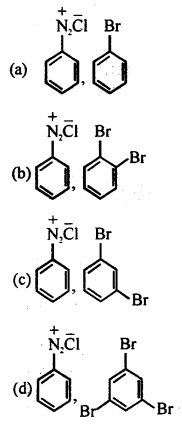
Answer
Answer: (a)
Question 25.
Alkyl halides are immiscible in water though they are polar because
(a) they react with water to give alcohols
(b) they cannot form hydrogen bonds with water
(c) C -X bond cannot be broken easily
(d) they are stable compounds and are not reactive
Answer
Answer: (b) they cannot form hydrogen bonds with water
Question 26.
Which one of the following is not correct order of boiling .points of the alkyl/aryl halides?
(a) CHCl3 > CH2Cl2
(b) CH3(CH2)3CI > CH3(CH2)2Cl
(c) (CH3)3CCl > (CH3)2CHCH2Cl
(d) CH3(CH2)3Cl > CH3CH2CHClCH3
Answer
Answer: (c) (CH3)3CCl > (CH3)2CHCH2Cl
Question 27.
Which of the following compounds will have highest melting point?
(a) Chlorobenzene
(b) o-Dichlorobenzene
(c) m-Dichlorobenzene
(d) p-Dichlorobenzene
Answer
Answer: (d) p-Dichlorobenzene
Question 28.
Ethyl alcohol is obtained when ethyl chloride is boiled with
(a) alcoholic KOH
(b) aqueous KOH
(c) water
(d) aqueous KMnO4
Answer
Answer: (b) aqueous KOH
Question 29.
Which of the following alkyl halides undergoes hydrolysis with aqueous KOH at the fastest rate?
(a) CH3CH2CH2Cl
(b) CH3CH2Cl
(C) CH3CH2CH2CH2Cl
(d) CH3CH2CH (Br) CH3
Answer
Answer: (d) CH3CH2CH (Br) CH3
Question 30.
Butane nitrile can be prepard by heating.
(a) propyl alcohol with KCN
(b) butyl chloride with KCN
(c) butyl alcohol with KCN
(d) propyl chloride with KCN
Answer
Answer: (d) propyl chloride with KCN
Question 31.
Which of the following reactions will give the major and minor products?

(a) (a) is major product and (b) is minor product
(b) (a) is minor product and (b) is major product
(c) Both (a) and (b) are major products
(d) Only (b) is formed and (a) is not formed
Answer
Answer: (a) (a) is major product and (b) is minor product
Question 32.
![]()
The final product in the reaction is
(a) CH3OH
(b) HCOOH
(c) CH3OH
(d) CH3COOH
Answer
Answer: (d) CH3COOH
Question 33.
The end product (Q) is in the following sequence of reaction
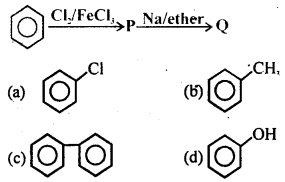
Answer
Answer: (c)
Question 34.
Methyl bromide reacts with AgF to give methyl fluoride and silver bromide. This reaction is called
(a) Fittig reaction
(b) Swarts reaction
(c) Wurtz reaction
(d) Finkelstein reaction
Answer
Answer: (b) Swarts reaction
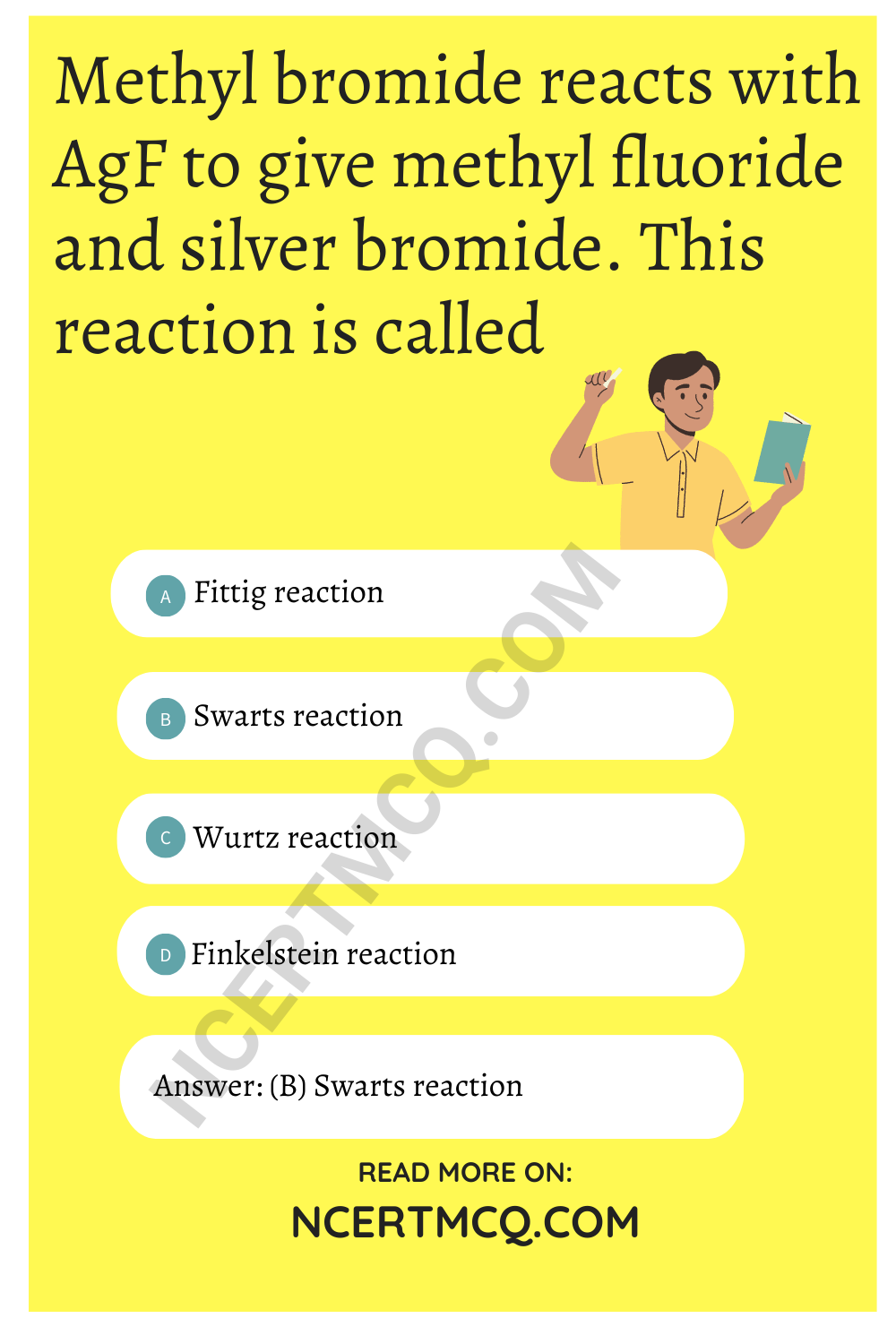
Question 35.
The alkyl halide is converted into an alcohol by
(a) elimination
(b) dehydrohalogenation
(c) addition
(d) substitution
Answer
Answer: (d) substitution
Question 36.
A mixture of 1-chloropropane and 2-chloropropane when treated with alcoholic KOH gives
(a) prop-1-ene
(b) prop-2-ene
(c) a mixture of prop-1 -ene and prop-2-ene
(d) propanol
Answer
Answer: (a) prop-1-ene
Question 37.
An alkyl halide, RX reacts with KCN to given propane nitrile, RX is
(a) C3H7Br
(b) C4H9Br
(c) C2H5Br
(d) C5H11Br
Answer
Answer: (c) C2H5Br
Question 38.
In SN2 reactions with the sequence of bond breaking and bond formation is as follows
(a) bond breaking is followed by formation
(b) bond formation is followed by breaking
(c) bond breaking and formation are simultaneously
(d) bond breaking and formation take place randomly
Answer
Answer: (c) bond breaking and formation are simultaneously
Question 39.
Grignard reagents are formed by the reaction of alkyl halides by warming
(a) with alcoholic solution
(b) with MgCl2
(c) Mg in presence of dry ether
(d) with MgCO3
Answer
Answer: (c) Mg in presence of dry ether
Question 40.
Which of the following is the most reactive towards nucleophilic substitution reaction?
(a) ClCH2– CH = CH2
(b) CH2 = CH-Cl
(c) CH3CH = CH-Cl
(d) C6H6Cl
Answer
Answer: (a) ClCH2-CH = CH2
We hope the given NCERT MCQ Questions for Class 12 Chemistry Chapter 10 Haloalkanes and Haloarenes with Answers Pdf free download will help you. If you have any queries regarding Haloalkanes and Haloarenes CBSE Class 12 Chemistry MCQs Multiple Choice Questions with Answers, drop a comment below and we will get back to you soon.
Class 12 Chemistry MCQ:
- The Solid State Class 12 MCQ
- Solutions Class 12 MCQ
- Electrochemistry Class 12 MCQ
- Chemical Kinetics Class 12 MCQ
- Surface Chemistry Class 12 MCQ
- General Principles and Processes of Isolation of Elements Class 12 MCQ
- The p-Block Elements Class 12 MCQ
- The d-and f-Block Elements Class 12 MCQ
- Coordination Compounds Class 12 MCQ
- Haloalkanes and Haloarenes Class 12 MCQ
- Alcohols, Phenols and Ethers Class 12 MCQ
- Aldehydes, Ketones and Carboxylic Acids Class 12 MCQ
- Amines Class 12 MCQ
- Biomolecules Class 12 MCQ
- Polymers Class 12 MCQ
- Chemistry in Everyday Life Class 12 MCQ
